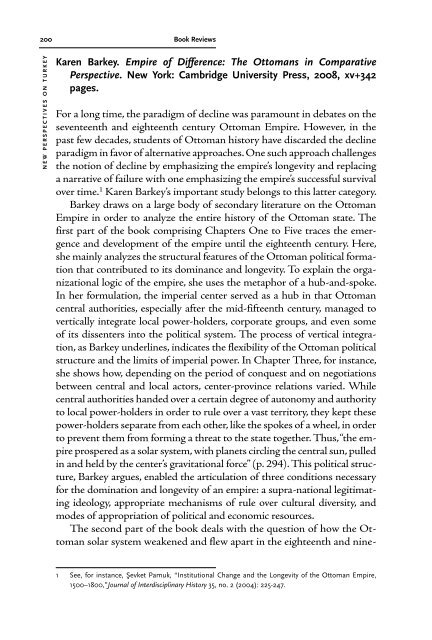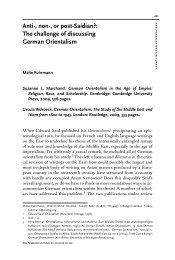Karen Barkey. Empire of Difference: The Ottomans in Comparative ...
Karen Barkey. Empire of Difference: The Ottomans in Comparative ...
Karen Barkey. Empire of Difference: The Ottomans in Comparative ...
You also want an ePaper? Increase the reach of your titles
YUMPU automatically turns print PDFs into web optimized ePapers that Google loves.
200 Book Reviews<br />
NEW PERSPECTIVES ON TURKEY<br />
<strong>Karen</strong> <strong>Barkey</strong>. <strong>Empire</strong> <strong>of</strong> <strong>Difference</strong>: <strong>The</strong> <strong>Ottomans</strong> <strong>in</strong> <strong>Comparative</strong><br />
Perspective. New York: Cambridge University Press, 2008, xv+342<br />
pages.<br />
For a long time, the paradigm <strong>of</strong> decl<strong>in</strong>e was paramount <strong>in</strong> debates on the<br />
seventeenth and eighteenth century Ottoman <strong>Empire</strong>. However, <strong>in</strong> the<br />
past few decades, students <strong>of</strong> Ottoman history have discarded the decl<strong>in</strong>e<br />
paradigm <strong>in</strong> favor <strong>of</strong> alternative approaches. One such approach challenges<br />
the notion <strong>of</strong> decl<strong>in</strong>e by emphasiz<strong>in</strong>g the empire’s longevity and replac<strong>in</strong>g<br />
a narrative <strong>of</strong> failure with one emphasiz<strong>in</strong>g the empire’s successful survival<br />
over time. 1 <strong>Karen</strong> <strong>Barkey</strong>’s important study belongs to this latter category.<br />
<strong>Barkey</strong> draws on a large body <strong>of</strong> secondary literature on the Ottoman<br />
<strong>Empire</strong> <strong>in</strong> order to analyze the entire history <strong>of</strong> the Ottoman state. <strong>The</strong><br />
first part <strong>of</strong> the book compris<strong>in</strong>g Chapters One to Five traces the emergence<br />
and development <strong>of</strong> the empire until the eighteenth century. Here,<br />
she ma<strong>in</strong>ly analyzes the structural features <strong>of</strong> the Ottoman political formation<br />
that contributed to its dom<strong>in</strong>ance and longevity. To expla<strong>in</strong> the organizational<br />
logic <strong>of</strong> the empire, she uses the metaphor <strong>of</strong> a hub-and-spoke.<br />
In her formulation, the imperial center served as a hub <strong>in</strong> that Ottoman<br />
central authorities, especially after the mid-fifteenth century, managed to<br />
vertically <strong>in</strong>tegrate local power-holders, corporate groups, and even some<br />
<strong>of</strong> its dissenters <strong>in</strong>to the political system. <strong>The</strong> process <strong>of</strong> vertical <strong>in</strong>tegration,<br />
as <strong>Barkey</strong> underl<strong>in</strong>es, <strong>in</strong>dicates the flexibility <strong>of</strong> the Ottoman political<br />
structure and the limits <strong>of</strong> imperial power. In Chapter Three, for <strong>in</strong>stance,<br />
she shows how, depend<strong>in</strong>g on the period <strong>of</strong> conquest and on negotiations<br />
between central and local actors, center-prov<strong>in</strong>ce relations varied. While<br />
central authorities handed over a certa<strong>in</strong> degree <strong>of</strong> autonomy and authority<br />
to local power-holders <strong>in</strong> order to rule over a vast territory, they kept these<br />
power-holders separate from each other, like the spokes <strong>of</strong> a wheel, <strong>in</strong> order<br />
to prevent them from form<strong>in</strong>g a threat to the state together. Thus, “the empire<br />
prospered as a solar system, with planets circl<strong>in</strong>g the central sun, pulled<br />
<strong>in</strong> and held by the center’s gravitational force” (p. 294). This political structure,<br />
<strong>Barkey</strong> argues, enabled the articulation <strong>of</strong> three conditions necessary<br />
for the dom<strong>in</strong>ation and longevity <strong>of</strong> an empire: a supra-national legitimat<strong>in</strong>g<br />
ideology, appropriate mechanisms <strong>of</strong> rule over cultural diversity, and<br />
modes <strong>of</strong> appropriation <strong>of</strong> political and economic resources.<br />
<strong>The</strong> second part <strong>of</strong> the book deals with the question <strong>of</strong> how the Ottoman<br />
solar system weakened and flew apart <strong>in</strong> the eighteenth and n<strong>in</strong>e-<br />
1 See, for <strong>in</strong>stance, Şevket Pamuk, “Institutional Change and the Longevity <strong>of</strong> the Ottoman <strong>Empire</strong>,<br />
1500–1800,”Journal <strong>of</strong> Interdiscipl<strong>in</strong>ary History 35, no. 2 (2004): 225-247.
teenth centuries. Here, <strong>Barkey</strong> emphasizes two processes which had their<br />
roots <strong>in</strong> the empire’s long eighteenth century (1695-1808): Life-time taxfarm<strong>in</strong>g<br />
and <strong>in</strong>ternational trade. On the one hand, grant<strong>in</strong>g life tenure to<br />
tax-farm<strong>in</strong>g local notables reduced the capacity <strong>of</strong> the Ottoman central<br />
state to appropriate economic resources necessary for military and other<br />
reforms <strong>in</strong> the n<strong>in</strong>eteenth century. International trade, on the other hand,<br />
radically changed the dynamics <strong>of</strong> diversity <strong>in</strong> the empire. In response<br />
to competition and <strong>in</strong>security fueled by <strong>in</strong>ternational trade, non-Muslim<br />
<strong>Ottomans</strong> chose to organize along ethnic and religious l<strong>in</strong>es. Likewise,<br />
Muslims who did not perform well economically began to <strong>in</strong>terpret their<br />
plight <strong>in</strong> religious terms. <strong>The</strong>se developments led to <strong>in</strong>ter-ethnic and religious<br />
tensions and, worse yet, violence, both <strong>of</strong> which were encouraged<br />
rather than conta<strong>in</strong>ed by the Ottoman state. Eventually the Ottoman solar<br />
system “flew apart leav<strong>in</strong>g a dim<strong>in</strong>ished sun” (p. 294).<br />
In this study, political agency belongs primarily to the elite sectors <strong>of</strong><br />
Ottoman society, with state elites <strong>in</strong> the center as the major, and sometimes<br />
only, creative political actors. Although <strong>Barkey</strong> does not provide sufficient<br />
historical evidence to back up her claim concern<strong>in</strong>g the horizontal<br />
segmentation <strong>of</strong> local elites, she frames the emergence, development, and<br />
then weaken<strong>in</strong>g <strong>of</strong> the Ottoman solar system as a negotiation process<br />
between the state and the local elites. In the n<strong>in</strong>eteenth century, however,<br />
this negotiated enterprise gave way to a unilateral reform project:<br />
“<strong>Ottomans</strong> therefore <strong>in</strong> their new understand<strong>in</strong>g <strong>of</strong> reform and centralization,<br />
embarked <strong>in</strong> the direction <strong>of</strong> nonempire, suspend<strong>in</strong>g negotiated<br />
forms <strong>of</strong> rule and the diversity <strong>of</strong> barga<strong>in</strong><strong>in</strong>g between state and society”<br />
(p. 265). Yet, recent studies on the n<strong>in</strong>eteenth-century Ottoman reforms<br />
that explore the social and political bases <strong>of</strong> the reforms <strong>in</strong> the prov<strong>in</strong>ces<br />
contradict her latter argument. 2 As <strong>Barkey</strong> overlooks this scholarship and<br />
<strong>in</strong>terprets the reforms <strong>of</strong> the long n<strong>in</strong>eteenth century as a top-down and<br />
forced centralization, nationalism/the nation-state appears as the only viable<br />
political project <strong>in</strong> the transition <strong>of</strong> the empire to a different political<br />
formation. But the facts that decentralist political organizations, such as<br />
the Liberty and Entente Party, found considerable support from Muslim<br />
and non-Muslim Ottoman subjects until the end <strong>of</strong> the empire and that<br />
Turks and Arabs sought possibilities for political cooperation even after<br />
World War I strongly suggest that this was not the case. 3<br />
2 See, for <strong>in</strong>stance, D<strong>in</strong>a Rizk Khoury, State and Prov<strong>in</strong>cial Society <strong>in</strong> the Ottoman <strong>Empire</strong>, Mosul, 1540–<br />
1834 (Cambridge: Cambridge University Press, 1997), and Jens Hanssen, F<strong>in</strong> de siècle Beirut: <strong>The</strong> Mak<strong>in</strong>g<br />
<strong>of</strong> an Ottoman Prov<strong>in</strong>cial Capital (New York: Oxford University Press, 2005).<br />
3 Hasan Kayalı, Arabs and Young Turks: Ottomanism, Arabism and Islamism <strong>in</strong> the Ottoman <strong>Empire</strong>, 1908-<br />
1918 (Berkeley: University <strong>of</strong> California Press, 1997).<br />
201<br />
NEW PERSPECTIVES ON TURKEY
202 Book Reviews<br />
NEW PERSPECTIVES ON TURKEY<br />
<strong>The</strong> way <strong>in</strong> which <strong>Barkey</strong> discusses the impact <strong>of</strong> <strong>in</strong>ternational trade<br />
on Ottoman polity and society also deserves attention <strong>in</strong> two respects.<br />
First, although domestic trade vastly exceeded <strong>in</strong>ternational trade <strong>in</strong><br />
the last two centuries <strong>of</strong> the empire, she ignores this important <strong>in</strong>ternal<br />
dynamic and partly reproduces a Eurocentric view <strong>of</strong> the Ottoman<br />
economy that puts primary importance on the connections between the<br />
European powers and the <strong>Ottomans</strong>. Secondly, her narrative concern<strong>in</strong>g<br />
<strong>in</strong>ternational trade tends to see Ottoman subjects, both Muslim and<br />
non-Muslim, as members <strong>of</strong> homogenous and hermetic communities.<br />
In Chapter Eight, for <strong>in</strong>stance, it seems as if all Christians were successful<br />
merchants or guild members who adapted to and benefited from <strong>in</strong>ternational<br />
trade, whereas the Muslim masses “were either unemployed<br />
or employed at the lowest rank with the lowest salaries” (p. 285). Here<br />
<strong>Barkey</strong> seems to be resurrect<strong>in</strong>g the idea that there existed an “ethnic<br />
division <strong>of</strong> labor” <strong>in</strong> the empire, a notion that has been conv<strong>in</strong>c<strong>in</strong>gly<br />
challenged by Ottoman labor historians. 4 Moreover, her analysis fails<br />
to take notice <strong>of</strong> the many bus<strong>in</strong>ess and labor organizations established<br />
collectively by <strong>Ottomans</strong> and foreigners com<strong>in</strong>g from different ethnic<br />
and religious backgrounds. <strong>The</strong>refore, cosmopolitan historical alternatives<br />
<strong>in</strong> the Ottoman past are left hidden from view.<br />
In the context <strong>of</strong> current <strong>in</strong>ter-ethnic, religious, and racial atrocities<br />
around the world, the questions that <strong>Barkey</strong>’s comprehensive framework<br />
addresses—that is, the longevity <strong>of</strong> the Ottoman <strong>Empire</strong> and how it<br />
managed diversity—rema<strong>in</strong> present and press<strong>in</strong>g. It is equally important,<br />
however, not to see the longevity, flexibility, and diversity <strong>of</strong> the<br />
empire as mere outcomes <strong>of</strong> <strong>in</strong>ter-elite negotiations, but to recognize<br />
the political challenges and demands raised by non-elite actors. Such an<br />
approach would help to uncover the various forms <strong>of</strong> social <strong>in</strong>equalities<br />
that <strong>Ottomans</strong> from different social classes suffered, as well as the political<br />
projects they pursued; therefore, it would provide a more dynamic<br />
and less determ<strong>in</strong>istic analysis <strong>of</strong> the Ottoman <strong>Empire</strong>, especially <strong>of</strong> its<br />
last century.<br />
Can Nacar<br />
Koç University<br />
4 See, for <strong>in</strong>stance, Cengiz Kırlı, “A Pr<strong>of</strong>ile <strong>of</strong> the Labor Force <strong>in</strong> Early N<strong>in</strong>eteenth-Century Istanbul,”<br />
International Labor and Work<strong>in</strong>g Class History, no. 60 (2001): 125-140, and Mustafa Erdem Kabadayı,<br />
“Work<strong>in</strong>g <strong>in</strong> a Fez Factory <strong>in</strong> Istanbul <strong>in</strong> the Late N<strong>in</strong>eteenth Century: Division <strong>of</strong> Labour and Networks<br />
<strong>of</strong> Migration Formed along Ethno-Religious L<strong>in</strong>es,” International Review <strong>of</strong> Social History 54, no. S17<br />
(2009): 69-90.



